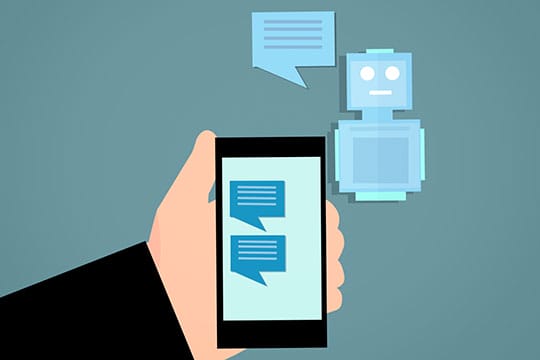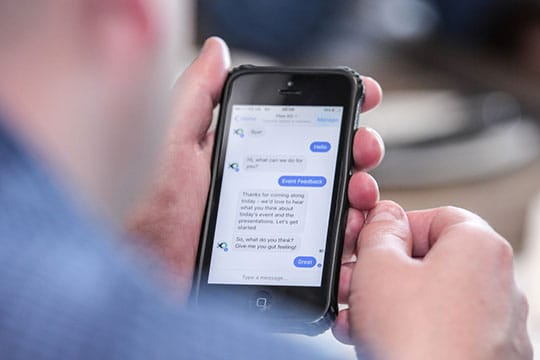If you’ve been online at any point over the past two years, you’ve undoubtedly come across a chatbot or two (maybe without even realizing it). While talking to robots used to be a pretty surreal experience, advances in Natural Language Programming (NLP) now lead to interactions with chatbots that can feel as instinctive as human conversation, and sometimes a lot less fractious.
Chatbots are becoming more and more of a fixture on customer service teams; their ability to swiftly respond to routine queries makes them great to have around. But reducing chatbots to customer service is doing them, and your brand, a disservice. Chatbots do a fantastic job at pointing customers towards the products they need, boosting your communications, and ensuring quasi-seamless integration between your online retail platforms and brick-and-mortar stores.
Let’s take an in-depth look at how chatbots can make you irresistible to your customers:
Chatbots Take Your Communications to the Next Level

If there’s one thing that consumers from across generations can agree on, it’s that they expect the brands they interact with to be up to speed. Literally so: taking your sweet time to get back to a potential customer will most likely cost you a sale. Five-minute response time is 21 times more likely to lead to a conversion than a thirty-minute turnaround.
If you’re the marketing lead for a multimillion-dollar company boasting a round-the-clock support team, that’s not that much of a problem. Smaller companies, solo entrepreneurs and those that are just starting out, however, will probably have a harder time staying on top of a rising tide of queries. Chatbots can be a great help in this case, by handling routine questions, pointing customers in the direction of the products they’re looking for and handing them over to a human agent when needed. What’s more, chatbots don’t need any sleep and can, therefore, man the fort while your team gets some well-deserved rest.
Chatbots can also help ensure you’re on top of your game when it comes to repeat customers. You’re probably aware, repeat customers are your best brand ambassadors. Take a leaf from the book of American railway company Amtrak, who rolled out their “Julie” chatbot in back in 2012. Julie was created in order to help customers with quick queries needing an instant answer and ultimately led to customers service savings of $1 million over the course of a year.
Recommended for you: Chatbots in Digital Marketing – How Marketers Can Benefit from it.
It Offers a Seamless Experience

If there’s one thing people love more than social media, it’s messaging. Mark Zuckerberg certainly thinks so, and we reckon he probably knows what he’s talking about. Nowadays, your chatbot can be seamlessly integrated into your own website. It can take some of the weight off the shoulders of your customer reps. It can also fit right into your clients’ favorite messaging apps. Platforms such as Facebook Messenger, Viber, WhatsApp and Slack offer the possibility to create low-cost, customizable chatbots for your brand. It saves your customers from having to trawl through your online resources in order to find what they’re looking for.
Messaging chatbots aren’t just beneficial from a convenience point of view. Consumers are bombarded by marketing just about everywhere they turn, leading to a loss of impact for traditional advertising forms. HubSpot recently compared content delivered via Facebook Messenger versus email and found that the former had an open rate of 80% and a click rate of 13% – far ahead of the good old email (respectively 33% and 2.1%).
Several companies are leading the way with intuitive chatbots. This not only gives customers the answers they need but also provide them with a great all-around experience. The beauty brand Sephora offers not one but two Facebook Messenger chatbots: one that helps customers book appointments, and another that enables them to find the lipstick shade they’re looking for based on a photo of an object. Their Kik bot also provides quizzes, makeup tips, video tutorials, and reviews and redirects potential customers towards the Sephora website.
It Helps You Give Customers What They Want

Any marketing professional worth their salt is well aware that knowing your customers is everything. And while it may seem counterintuitive to use bots in order to do this, chatbots are a source of valuable insight, especially the more sophisticated ones that make use of artificial intelligence and machine learning to analyze customer behavior.
AI-powered chatbots can draw upon a wide variety of data sources; such as social media profiles, search habits, interactions with your website and previous exchanges with your brand. This enables them to build up a detailed customer profile. In turn, will help you approach them with timely and relevant offers.
The coffee chain Starbucks is doing a great job with their My Starbucks Barista mobile app chatbot. Available via messaging or voice (the company also offers an Alexa skill), the bot takes into account previous purchases, customer preferences and factors such as location in order to suggest products and help users place orders.
At the same time, chatbots can carry out direct marketing research. Once they’ve made their purchase, customers are understandably reticent to spend another fifteen minutes filling out a detailed satisfaction survey. Chatbots can be used to obtain the exact same information, but without the cognitive overload that comes with staring down a form with 15 required fields. What’s more, the whole process won’t involve waiting weeks for data to be collected and analyzed, unlike traditional marketing surveys.
You may like: LiveAgent Live Chat Software Review – How Worthy it is?
Chatbots Are the Shop Assistants You’ve Always Dreamed of

How often do you head home after a shopping spree having bought exactly what you were looking for? I’d wager that your answer is not very often at all. Most of us tend to browse through a store before committing to one product. That goes for online shopping as well as brick-and-mortar shop fronts. The difference, you’re probably thinking, is that physical stores have assistants on hand to help point customers towards the products they need. Well, that can be true for your eCommerce site as well – if you bring in the bots.
You’re undoubtedly familiar with the Japanese retailer Uniqlo and their high-tech but affordable clothing. The company now offers its own “digital concierge”, known as Uniqlo IQ, which helps customers find the items they’re looking for alongside personalized style recommendations. It then ensures a quasi-seamless experience by directing buyers towards the nearest Uniqlo brick-and-mortar store with the requisite items in stock.
Chatbots have no limit when it comes to the number of customers they can serve at any given time. These are endlessly patient and provide a truly customized customer experience. By asking potential buyers questions about what kind of thing they’re looking for, giving them the choice between several different options and drawing on previous interactions. A chatbot can ensure they find something that’s suited to their needs and great all-round customer experience.
Making Chatbots Work for Your Brand

Now you’ve made it this far, you’re probably desperate to get started with your very own chatbot. Not so fast! Chatbots are a great way to increase customer engagement. It turbo-boost your sales and take some weight off the shoulders of your sales and marketing teams. But there are a few things to take into account before you get started:
1. Clarify Your Objectives
 What exactly are you hoping to achieve with your chatbot? Think about the various use-cases and discuss them in-depth with the requisite teams. These can include customer service, sales, operations, and UX. Knowing exactly what you need will help you define your ideal chatbots as well as what you’re looking for in terms of KPIs.
What exactly are you hoping to achieve with your chatbot? Think about the various use-cases and discuss them in-depth with the requisite teams. These can include customer service, sales, operations, and UX. Knowing exactly what you need will help you define your ideal chatbots as well as what you’re looking for in terms of KPIs.
2. Define Your Ideal Customer Experience
 Whatever area of business you decide to focus your chatbot on, customer experience has to be an utmost priority. Unwieldy and badly-programmed bots can feel unnatural on the customer side. This can quickly become a nightmare and ultimately do a lot of damage to your brand image.
Whatever area of business you decide to focus your chatbot on, customer experience has to be an utmost priority. Unwieldy and badly-programmed bots can feel unnatural on the customer side. This can quickly become a nightmare and ultimately do a lot of damage to your brand image.
3. Decide What to Automate
 Not everything needs to be automated, and a perceived lack of human interaction can be extremely frustrating for customers. As shown in the above examples, chatbots are great at handling simple queries. It can guide customers towards the right products and offers and processing payments. They’re not (yet) that great at de-escalating conflicts or dealing with more complex situations. Make sure your bots are able to hand customers over to human agents when needed.
Not everything needs to be automated, and a perceived lack of human interaction can be extremely frustrating for customers. As shown in the above examples, chatbots are great at handling simple queries. It can guide customers towards the right products and offers and processing payments. They’re not (yet) that great at de-escalating conflicts or dealing with more complex situations. Make sure your bots are able to hand customers over to human agents when needed.
4. Look Towards the Future
 Work hand-in-hand with your IT team to make sure that your chatbot is future-proof. This will involve ensuring that your infrastructure is scalable. You are able to move to the next level both from a technical and a customer experience point of view.
Work hand-in-hand with your IT team to make sure that your chatbot is future-proof. This will involve ensuring that your infrastructure is scalable. You are able to move to the next level both from a technical and a customer experience point of view.
You may also like: Softros LAN Messenger Review – A Secured Chat & File Sharing Tool for Your Company.
Final Words

In conclusion? As you’ve probably gathered, if you don’t have a chatbot in this age, then you’re most definitely missing out. Chatbots ensure your communications are in pace with customer expectations in 2019. They also help potential buyers find the products they were looking for in the first place – and more. Make sure you are working with clearly-defined objectives. Get all the requisite team members on board. And you’ll soon be on the road to success.
This article is written by Rebecca Brown. Rebecca is a translator, an interpreter and a digital nomad, living her best life while traveling the world and breaking out of her shell. Her ultimate dream is to visit every country in the world, and she has so far been to 49. When not writing or trying to find the perfect cappuccino, she tries to blog at RoughDraft. Once a social media addict, she now has a very rarely used Twitter account.





